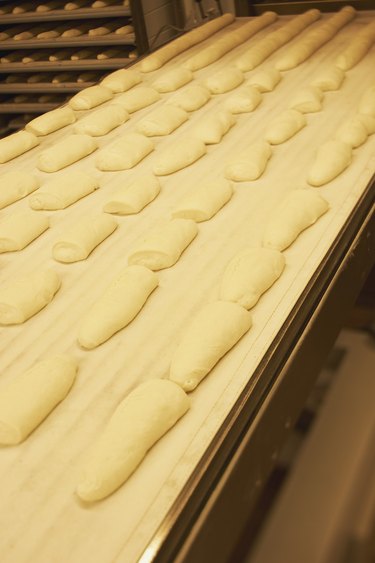
Exploring vintage cookbooks can be great fun for cooks and bakers, though adapting to outdated techniques and now-rare ingredients can make it challenging. For example, many cookbooks dating from the first half of the 20th century call for yeast in cake form, which is now relatively rare and not stocked in all stores. Converting an old recipe to use dry yeast -- or a modern recipe to use cake yeast, once you've found it -- is relatively straightforward.
A Quick Yeast History
Video of the Day
Archaeologists have demonstrated that breads risen with wild yeasts were already well known in ancient Egypt and Mesopotamia, but it wasn't until the late 19th century that they were identified by French scientist Louis Pasteur. Pasteur's quest for pure, refined yeast was intended to revolutionize the wine industry -- which it did -- but brewers and bakers benefited as well. Within a few short years, manufacturers had begun producing purified fresh yeast in cake form for professional and home bakers. Compared to older techniques using starters or sourdough, fresh yeast produced a much faster and more reliable loaf of bread.
Video of the Day
Fresh Versus Dry Yeast
Fresh yeast is the preferred version for the most serious bakers, because the yeast cells are live and fully active as soon as it's added to the dough. It begins rising the dough quickly, and it lasts longest in the kind of slow-rising doughs favored by artisanal bakers. Unfortunately, it's also highly perishable. In weeks or even days, it can die or become moldy and unusable. Active dry yeast addresses that problem by drying out the yeast cells, rendering them dormant and surrounding them with a protective shell of dried yeast cells. Dry yeast can last for months on the shelf, rather than days in the refrigerator, making it a more practical option for home bakers.
Doing the Math
Active dry yeast is sold in small envelopes weighing 7 grams, or 1/4 ounce, and measuring 2 1/4 teaspoons. That's enough yeast to leaven a batch of bread with 3 to 4 cups of flour. Fresh cake yeast is sold in two sizes, smaller blocks of 0.6 ounce or larger cakes of 2 ounces. One small block, or one-third of the larger block, is equivalent to an envelope of dry yeast and will raise the same amount of dough. If you're converting from a recipe that measures its ingredients in weights, you'll have to do the math. Multiply the weight of fresh yeast by 0.4 to arrive at the correct weight of dry yeast, or divide the amount of dry yeast by 0.4 to convert to fresh yeast.
A Few Other Details
Fresh yeast and dry yeast are both liveliest when they're warm, but they require slightly different temperatures. Recipes using dry yeast usually specify that your wet ingredients should be at a temperature of about 110 degrees Fahrenheit, nicely warm to the touch. Fresh yeast isn't surrounded by a shell of dead cells, so it favors liquids at about 90 to 95 F, just lukewarm to the touch. Both can be started in water if you wish, to ensure that they're alive and working, or can be added directly to the dry ingredients and then moistened when the liquids are added to the dough. It's largely a matter of personal preference, and finding what works for you.